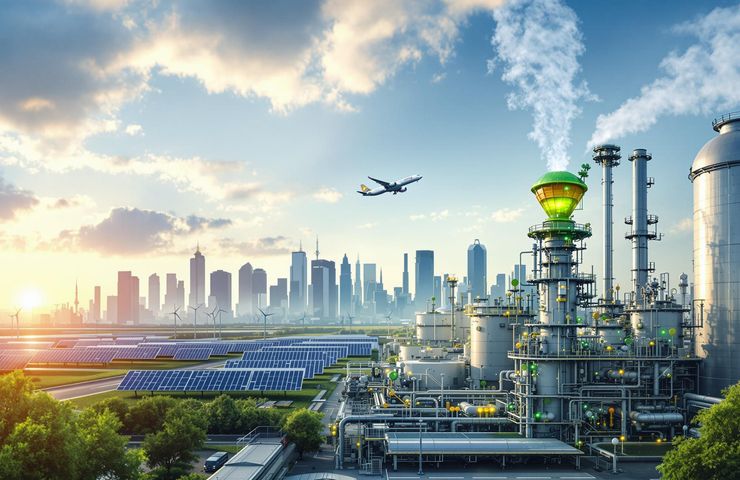
Sasol Catalysts to Boost Hydrogen-Based e-Fuel Yields at INERATEC’s PtL Facility in Germany
July 25, 2025Sasol Chemicals and INERATEC are teaming up to give synthetic sustainable aviation fuel (or e-SAF) a serious boost. The two companies just signed a Letter of Intent that could shake things up in the world of hydrogen-based fuel. The focus? Rolling out next-gen cobalt Fischer-Tropsch (FT) catalysts at INERATEC’s flagship ERA ONE Power-to-Liquid (PtL) facility near Frankfurt, Germany—with hopes of bumping up e-kerosene production by as much as 15% starting as soon as 2026.
Blending Legacy with Innovation
This partnership is rooted in a technology that’s been around for nearly a century: Fischer-Tropsch synthesis. Developed in Germany in the 1920s, it turns a mix of hydrogen and carbon monoxide (aka synthesis gas) into liquid hydrocarbons. Fast forward a few decades, and South Africa’s Sasol took it to a whole new level, using cobalt-based FT catalysts to help secure domestic energy supplies. Now, those very catalysts are getting a modern twist—helping to push the transition toward sustainable energy, especially in aviation where going electric isn’t quite an option yet.
On the other side of the partnership, Germany’s INERATEC, founded in 2016, has carved out a name for itself in Power-to-Liquid innovation. The company is known for taking renewable electricity, captured CO2, and green hydrogen, and transforming them into e-fuels. Their ERA ONE plant, just outside Frankfurt, is currently the largest operational PtL facility in the world. By adding in Sasol’s new FT catalyst tech, INERATEC hopes to squeeze more e-kerosene out of every drop of hydrogen—critical when green hydrogen is still expensive and limited.
The Tech Behind the Transition
Here’s how it all fits together: renewable power is used to run electrolysis, which splits water into hydrogen and oxygen. That green hydrogen is then combined with captured CO2 in a reactor loaded with Sasol’s cobalt FT catalysts. These catalysts help convert the mix into long-chain hydrocarbons—things like e-kerosene or e-wax. After some refining, the result is a clean, jet-ready fuel. It’s all about making the most out of limited inputs, and every bit of efficiency counts.
Why This Matters Now
Let’s be clear—the clock is ticking. Aviation contributes about 2–3% of global CO2 emissions, and regulators are tightening the screws. The European Union is already requiring minimum SAF quotas in jet fuel blends by 2030. But cost is a major hurdle, and right now, things like green hydrogen production and CO2 capture are pricey and not widely available. So, a 15% bump in yield really moves the needle.
“This isn’t just an incremental improvement,” noted one analyst at the recent Frankfurt Energy Transition Forum. “It represents a fundamental shift that could make e-fuels more competitive—and less dependent on government subsidies.”
Two Heavyweights in Strategic Sync
Lots of companies are chasing the PtL SAF dream, but Sasol and INERATEC bring something special to the table: deep technical expertise and serious execution power. With Sasol stepping beyond its South African roots and INERATEC pushing the boundaries of sustainable fuel innovation, this partnership is well-positioned to lead the charge.
The ERA ONE facility is really just the beginning. INERATEC is already planning a new plant in the Port of Amsterdam that could churn out 35,000 tons of synthetic fuels per year by 2027, this time with help from Zenith Energy Terminals. And there’s more brewing—cross-continental research and supply chain optimization means both companies are in it for the long haul, and they’re thinking globally.
The Road Ahead: Challenges? Definitely. Potential? Huge.
No one’s pretending this is a walk in the park. While catalyst tech is improving, the cost and infrastructure challenges around green hydrogen production and CO2 capture are still very real. There’s also the simple truth that fossil jet fuel is still cheaper—for now.
Even so, moves like this show that the industry isn’t sitting still. Boosting catalyst efficiency helps stretch every kilogram of hydrogen further, improving returns across the PtL fuel cycle. And Germany, with its advanced chemical industry and skilled workforce, is shaping up to be a key player in this evolving landscape.
Looking Ahead
The clock is ticking, regulations are tightening, and the need for cleaner aviation fuel is only growing. This Sasol-INERATEC partnership is more than a technical upgrade—it’s laying the groundwork for a new era in fuel production. With eyes on 2026 for real-world impact, this project has the potential to show the world how we can scale high-energy fuels cleanly and smartly using hydrogen production and PtL technology.
For everyone in the hydrogen and synthetic fuel game, this isn’t just another headline—it’s a sign of what’s possible when innovation meets execution. In the race to make aviation cleaner, every invention, every improvement, and every partnership matters more than ever.



 With over 15 years of reporting hydrogen news, we are your premier source for the latest updates and insights in hydrogen and renewable energy.
With over 15 years of reporting hydrogen news, we are your premier source for the latest updates and insights in hydrogen and renewable energy.